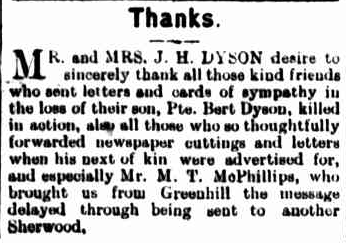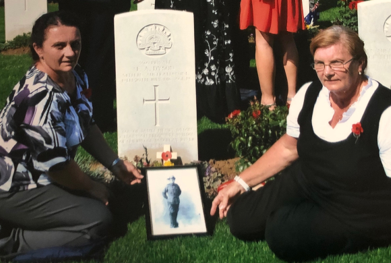
Frederick Arthur DYSON
Eyes brown, Hair dark brown, Complexion dark
Fred Dyson – the first man buried at Pheasant Woods Military Cemetery.
We acknowledge the research, images and stories kindly shared by the Macleay River Historical Society (MRHS) and many members of the broader Dyson family.
In the 2013 book, Fromelles: The Final Chapters, co-author Tim Lycett reported (page 204) that he was fortunate to watch the first burial, on a frosty morning in January 2010. It was a very formal ceremony by British and Australian military with a chaplain and all honours, completed “by a crisp volley of rifle fire”. He wrote, “At the time, no one was aware who this first solder actually was. We now know from DNA testing that, after nearly 94 years, Fred Dyson had finally been laid to rest in the honourable grave that he had always deserved.”
And for Fred’s family, when the news came through that his remains had been identified there was a sense of relief and delight that he had been found but mixed with the ongoing sadness of a life lost too early. When family also learned that Fred had been the first buried in the new Pheasant Wood cemetery at Fromelles, the news was received as an honour and a privilege. It seems fitting that an ordinary and unassuming private – not yet 20 years of age - from a small country town in Australia was the first to be buried representing all the other ordinary, young and unassuming soldiers who had given their lives in service and remained lost for nearly a century.
Who was Fred Dyson?
Fred Dyson was the youngest of three brothers who enlisted in the AIF:
- William Stanley (Bill) born 18 March 1893 - 2464, 2nd Light Horse
- Bertie Edward born 8 October 1894 - 3559 18th Battalion
- Frederick Arthur born 6 October 1896 – 3560 18th Battalion
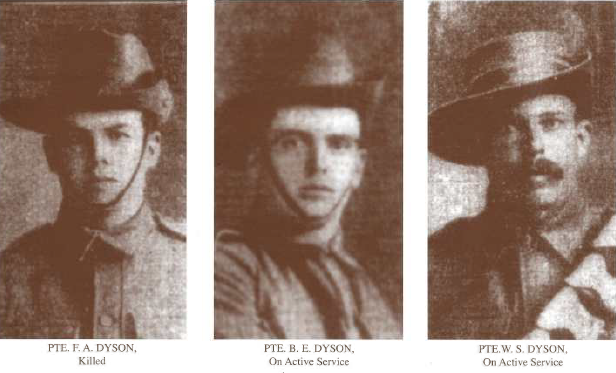
When he enlisted in October 1915, he gave his age as 19 years and 2 months and was working as a labourer. His family lived on a farming property in the Macleay River area near Kempsey, more than 400 kilometres from Sydney. Fred was born in Yaravel and attended the local public schools, including both the Corangula and Sherwood schools. His family address is noted as Lovelock Creek, Sherwood.
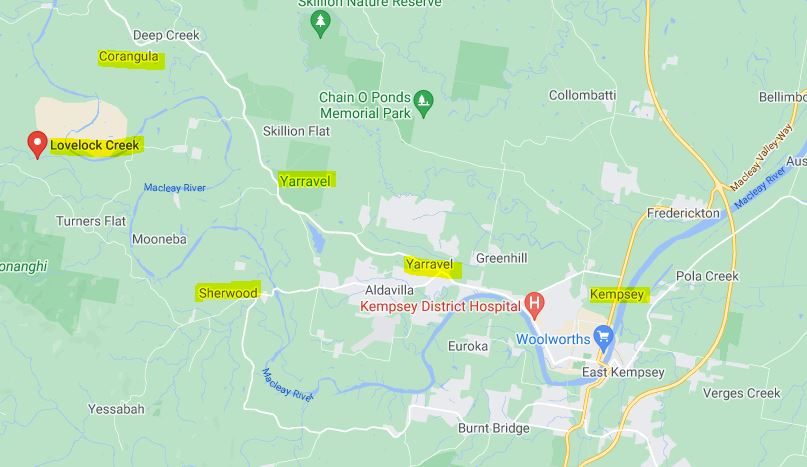
Fred and Bert enlisted together and were given a farewell on 13 December 1915, where they were presented with a purse of sovereigns:
“On Monday night, at “Waldron,” the residence of Mr. and Mrs. W.H. Rowe, the residents of Corangula and surrounding centres accorded a most hearty farewell to Privates Fred, and Bert Dyson and H. Booth, which three were present on final leave. …... Much eulogistic reference was made to the three stalwart Australians in khaki, and more than one tear was silently dropped anent the necessity of their going.”
The two Dyson brothers were allocated to the 18th Battalion with consecutive service numbers. After a brief period of initial training, Bert and Fred left Australia together on HMAT A60 Aeneas just five days before Christmas 1915. On arriving in Egypt, training of the new recruits began in earnest as part of the AIF’s reorganisation post-Gallipoli – though both Fred and Bert joined many other young soldiers coming down with the mumps and were briefly admitted to hospital in early March.
By the end of March, though, the Dyson brothers were separated. Bert was sent to France and allocated to Base Depot while Fred remained in Egypt and was transferred to the newly formed 54th Battalion.
The Western Front
In June, Fred was also sent to France. The 54th left Alexandria on 19 June 1916 and disembarked in Marseille on 29 June 1916. The Battalion was soon in the trenches and fought its first major battle at Fromelles on the night of 19-20 July. The Australian War Memorial described it as a disaster with the 54th suffering casualties equal to 65 per cent of its fighting strength.
Private Fred Dyson was reported missing 19-20 July 1916. Nothing further was known until his name appeared on the German death list dated 4 November 1916 and his identification disc returned by the Germans. This news was passed on to grieving family by the Red Cross with the letter published in the local newspaper on 21 March 1917.
To help find certainty, the Red Cross sought evidence from survivors of the battle. On 18 January 1917, Private John R. Matthews, 4211, 15 Platoon, D Company, 54th Battalion, testified that:
'Pte. R. Clark D Co. XV pltn. told me that he saw Dyson killed in the German line at Fromelles on 19th July'.
Private David Chapman also gave the following eyewitness report.

In May 1917, a court of inquiry made a formal finding that Fred had been killed in action on 19-20 July 1916.
But Fred had no known grave and he was to remain missing for almost a century.
The other Dyson brothers’ war service
Bert DYSON 1894-1917
Christened Bertie Edward Dyson, Bert enlisted at Kempsey in October 1915 with his brother, Fred, who was younger by two years.
The brothers arrived together in Egypt in January 1916 with the 18th Battalion but at the end of March the brothers were separated when Bert was sent to France where he was attached to the Base Depot for some time.
It is unclear where Bert was based in that time or whether Fred and Bert managed to catch up during the brief few weeks when Fred was in France before Fromelles.
From his records, Bert had been hospitalised during June but was transferred back to duty rejoining the 18th on 1 August 1916. On 5 August, he suffered a gunshot wound to his leg for which he was eventually invalided to England for treatment.
By February 1917, Bert was back in France with his unit and in May he was hospitalised twice – once for measles and again for trench fever.
He rejoined his battalion on 1 September and was killed in action in Belgium on 20 September 1917, just weeks shy of his 23rd birthday.
A cable was sent home to family but unfortunately it went to the wrong address and the Army advertised in late October for updated contacts for the Dyson family.
It seems this advertisement was brought to the Dyson family’s attention by concerned friends and family and official news of Bert’s death was received in early November.
With no known grave, Bert is commemorated on the Menin Gate, one of about 6,000 Australian soldiers listed there.
Since 2019, however, hopes have been raised that Bert’s final resting place may possibly be identified. Bert’s great-nephew, Philip Lee, advises in his book Macleay Fallen (2021, page 65) that the Unrecovered War Casualties Unit (UWCA) have contacted the family to obtain a maternal mitochondrial DNA donor in the hopes of finding a match.
With testing and research delayed during the COVID-19 pandemic, the family are still awaiting news from UWCA.
William (Bill) Stanley DYSON 1893-1980 and the 2nd Light Horse

Bill Dyson, aged 22, followed his younger brothers to enlist in January 1916 as they were enroute to Egypt. He joined the 7th Light Horse Regiment and left Australia on HMAT A39 Port Macquarie on 26 April 1916.
He was later transferred to the 2nd Light Horse Brigade Machine Gun Squadron and served in Egypt and Palestine as a driver until he returned to Australia in 1919.
Bill married Minnie Miles in 1928 and remained in the Kempsey district until his death in 1980.
The three Dyson brothers remembered
Back home, the three Dyson brothers, Fred, Bert and Bill, are listed on the Sherwood Public School and District Great War Honour Roll, now housed in the Kempsey Museum (MRHS). Their mother was asked to unveil this memorial on 12 November 1919 as Mr and Mrs Dyson “had given so much for their country” with three sons at the front, two were killed. Source Macleay Argus, 14 Nov 1919, page 5
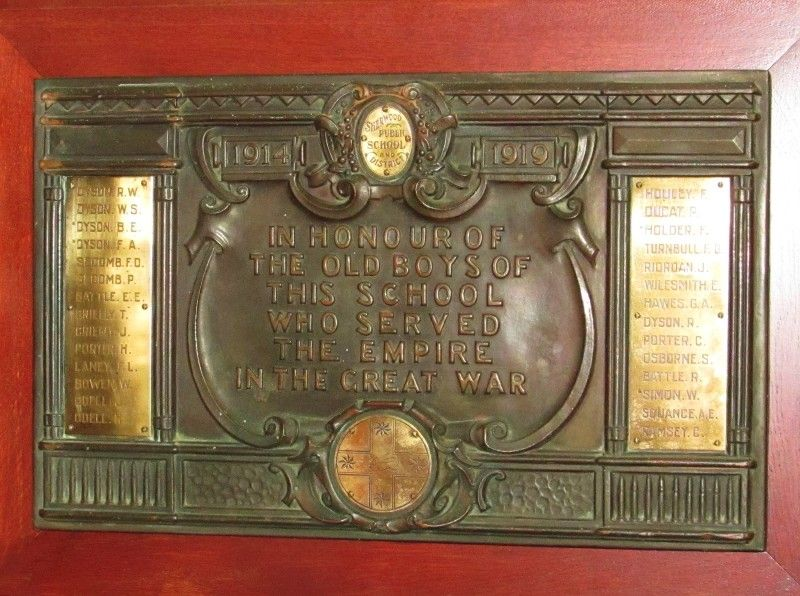
The Dyson brothers’ names also appear on the Corangula Public School Honor Roll unveiled in December 1917. It was described earlier that year (before Bert’s death) as:
“… an extremely neat and artistic piece of work in copper, and a credit to the people choosing it and subscribing for its erection. Beneath the bold heading "Honor Roll" are the letters of the word Anzac on the rays of the rising sun, flanked by 1914, the year the war started, and a corresponding space for the year the war ends.
Immediately below is a fine representation of the ideal Australian soldier, in a trench with parapet of sandbags, and flanked with the Union Jack and Australian flag; while subjoined is space for the roll of, to quote the tablet, "Boys of Corangula who answered the call of King and Country."
The names already thereon are T. Salmond, J. H. Salmond, H. H. Booth, L. S. Kesby, F. A. Dyson, B E. Dyson, W. S. Dyson, J. Rowe; and of these, we regret to say, Fred. Dyson was killed in action, while B. Dyson and T. Salmond are among the wounded.”

FINDING Fred
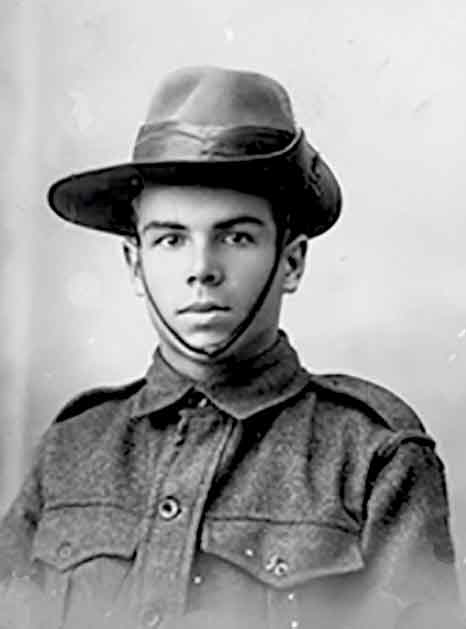
Fred had a lot of relatives – descendants of his siblings Nora, Styles, William, Charles, George and Lilla – in the Macleay district around Kempsey, now spread far and wide. Generally, they knew little of Fred or Bert though in recent years family members like Phil Lee and Eleanor Macnamara have undertaken considerable research.
Their great-niece, Sharon Horsnell, recalled:
“Our grandparents and parents didn’t really talk about the war. It wasn’t until I was older that my mum told me about Fred and Bert. She said grandfather said it was too sad to talk about. My mother, Vonda Dyson, told me of a soldier named Doust who, after returning home from the war, went to all the trouble of coming down from Grafton and finding Fred’s parents at Lovelock Creek. He told them that three soldiers jumped into a hole and that Fred would never have known what hit him.”
The Doust Connection:
The soldier from Grafton was likely a connection of two Doust cousins who served in both the 18th and 54th Battalions with Fred and Bert and had immediately consecutive service numbers. Both cousins fought at Fromelles. The younger cousin, Willie Doust 3557, was killed in action at Fromelles and, like Fred, is buried at the Pheasant Wood cemetery. 3558 Roy Doust was wounded during the battle of Fromelles and was evacuated to England where he died of his wounds on 30 October 1916. There were at least two other cousins from the broader Doust family (2555 Arthur and 19878 Reuben) who survived the war and may have visited the grieving Dyson family to give what comfort he could.
Great-nephew Phil Lee also recalls that his grandmother (Nora, older sister to Fred and Bert) would never speak of the war:
“Like many other Macleay families my grandmother and her family had suffered deep sorrow from the tragic loss of loved ones in this conflict.”
Nora had named two of her eight sons after her brothers Fred and Bert who had gone to war and never returned.
When, in 2010, the news came through that Fred’s remains had been identified there was a sense of relief and delight for his family that he had been found but mixed with the ongoing sadness of a life lost too early. When family also learned that Fred had been the first buried in the new Pheasant Wood cemetery at Fromelles on 30 January 2010, the news was received as an honour and a privilege. It seems fitting that an ordinary and unassuming private from a small country town in Australia was the first buried - representing all the other ordinary and unassuming soldiers who had given their lives in service but had been lost for nearly a century.
“It was with excitement and sadness that I answered the phone call that morning 16th March 2010,” reported Sharon Horsnell, one of Fred’s great-nieces. The army told her that they had identified her grandfather’s brother, Pte Fred Dyson, amongst the remains of the soldiers from the Pheasant Wood site. “It was so sad knowing they had been buried there so long ago by the Germans and Fred’s parents had been asking for word of their two sons’ final resting place.” They were never to know where either Fred or Bert were buried but they did have the comfort of receiving their identity discs.
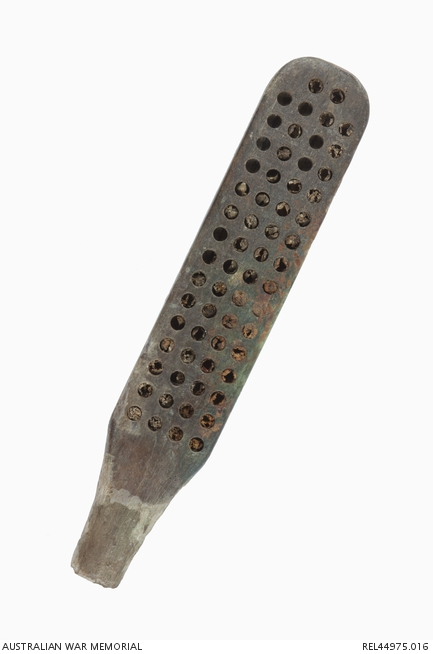
Sharon’s father, Don, was the son of George Dyson, younger brother to Fred and Bert. Don provided his DNA for identifying Fred. He also gave approval for his DNA to be used if the opportunity ever arose to identify Fred’s brother, Bert Dyson, who is remembered at the Menin Gate.
Dyson family at the 2010 Ceremony at Fromelles
“After hearing news of Fred’s identification, I then decided I needed to go to the Fromelles commemoration day,”
“Not for me, but for Fred’s parents (James and Hannah), and our grandfather, George. It was sad to think that they had died, not knowing that Fred had been found.”
Not wanting Sharon to go alone, her sister Julie and her husband Allan changed their flights to join her in Paris and then Lille. On the day of the service, they were up early to be at the train station to catch the buses to take them to Fromelles. Sharon and Julie recalled:
“Entering Fromelles, the little French town, it was a beautiful cheerful sight to see, as it had been decorated with flags and bunting hanging from every window. It was a very hot day but a lovely and moving ceremony. It was especially emotional when we finally got to be near Fred’s grave.”
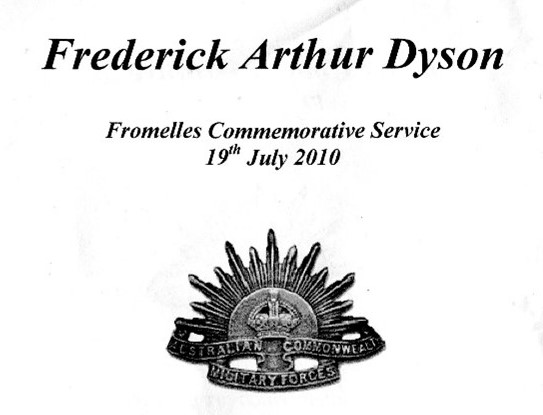
After the main ceremony, a small service was held for Fred with the chaplain. He was an Englishman and he said, ”I hope you don’t mind, I’m C of E”. His great-nieces replied, “So was Fred.”
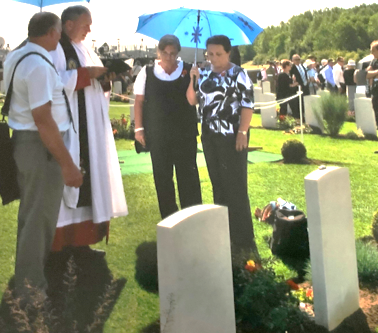


The two sisters also recall that some young Australian soldiers introduced themselves as having been pallbearers for Fred when his remains were re-buried on 30 January 2010 though at the time, they had wondered about who they were carrying. When shown Fred’s photo, they paused and reflected, “Fred was younger than us.”
While members of the Dyson family stood near Fred’s headstone, a group from the FFAIF approached and asked them to hold out their hands. Carefully, they handed over a small stone. They explained that a member of their party had been hospitalised and had asked them to put the stone from the Macleay River into the hands of the Dyson family and to ask them to put it on Fred’s headstone. This was done with pride and reverence marvelling at the connections these young men were still forging even though they had been gone so long.
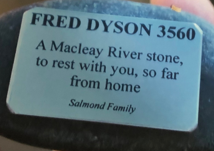
Geoff Cuckson, the family member of another Fromelles soldier (Pte 3032 William J. Cuckson) recalls seeing the Macleay River stone on Fred Dyson’s headstone some days after the official ceremony.
He was very moved at the sight and took a photo of the headstone. He was further moved to discover some years later that another of his great-uncles, John Ernest Cuckson, known as Ernie Hand, had been adopted by the Hand family in Kempsey on the Macleay River and had grown up as a contemporary of Fred Dyson.
The coincidences and connections touching Fromelles abound.
In addition to the stone from the Macleay River, gum leaves from home were also placed reverently on Fred’s grave. Included with the leaves is a plaque, a replica of the Corangula Public School Honor Roll described earlier from the 1917 news article.
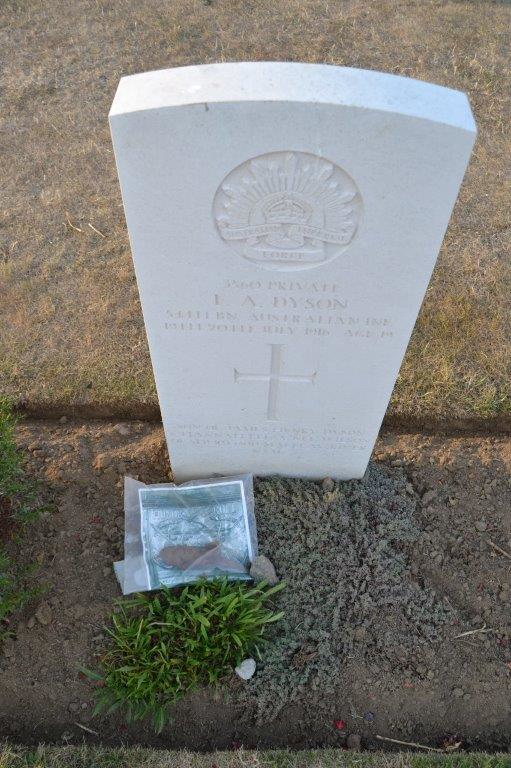
While Fred had been lost for nearly a century and the memory of his life and story had faded for a while, he has now been found and he will be remembered:
“I have since told my children and grandchildren about Fred, Bert and William and have shown them photos of these soldiers. Fred also had cousins who were in this war. They will not be forgotten.”
Their story has also been preserved and re-told in MRHS Journal articles and in a 2021 book by Philip Lee titled Macleay Fallen.
The Fromelles Association would love to hear from you

Contacts
(Contact: carla@fromelles.info or geoffrey@fromelles.info).
(Contact: army.uwc@defence.gov.au or phone 1800 019 090).
Donations
If you are able, please contribute to the upkeep of this resource.
(Contact: bill@fromelles.info ).


